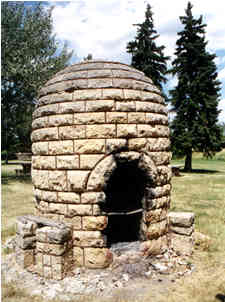 |
This beehive barbecue
pit in Graeser Park in Robbinsdale is one of the few original structures
remaining from wayside rests along historic Hwy 100. It was built during
the 1930s by stonemason John Schulte of Minneapolis. Each stone was cut
by hand from a wooden pattern. The design and high quality of craftsmanship
of the stove is one reason Hwy 100 is eligible for the National Register
of Historic Places. Photo by Craig Wilkins
|
A documentary recalling the creation during the 1930s of Hwy 100 and its famous
"Lilac Way" will premiere Sept. 11 at the Minnesota History Center,
and will air on public television Sept. 26.
Mn/DOT partnered with Twin Cities Public Television to make the documentary,
which will help preserve a piece of Minnesota transportation history, according
to Donna Lindberg, Communications and Public Relations.
Reconstruction of 5.3 miles of Hwy 100 from Golden Valley to Brooklyn Center
has required the removal of wayside rest structures built during the Depression.
Federal and state historical preservation guidelines require that Mn/DOT mitigate
the removal of historic artifacts by recording their history. Traditionally
this has been done in report format, Lindberg said.
"The film is a way of meeting the requirements and involving and educating
the people in the communities affected by the project," Lindberg said.
The documentary features individuals who worked on the project and highlights
the thousands of lilac bushes and five wayside rests that once lined the historic
highway. Retired Mn/DOT Administrative Services director Lee Nelson is interviewed
in the documentary.
Rustic picnic areas, cloverleaf intersectionsóand 7,900 lilacs
Lilac Way, designed in the 1930s to route traffic around Minneapolis, was an
early prototype for todayís beltline highway, according to Barbara Averill,
media relations manager for the Minnesota History Center.
In addition, she said, Lilac Way was the largest Works Progress Administration
project in the state. (The WPA was created by the Roosevelt Administration during
the Depression to provide work for unemployed Americans.)
Averill said Lilac Way was innovative in several ways: it included cloverleaf
intersections and wayside rests where drivers could stop and enjoy a picnic,
a novel idea in the 1930s.
"The roadside stops included stone tables and benches, walkways and barbecues,"
said Jackie Sluss, historian for Mn/DOTís Cultural Resource Unit. "The
highway and the wayside rests were found to be eligible for the National Register
of Historic Places because Hwy 100 was the earliest modern freeway-style roadway
in Minnesota and represents the best efforts of the work-for-relief programs
to build infrastructure and public amenities throughout the state.
"The project illustrates how the Minnesota Highway Department partnered
with innovative federal programs to bring hundreds of local laborers and craftsmen
together to build an important piece of infrastructure," Sluss said.
Some picnic artifacts and shrubs saved
Before $100 million worth of improvements began this summer, crews removed
200 lilac bushes and dismantled part of the three remaining rest areas. The
beehive barbecue at Graeser Park in Robbinsdale still remains. Sluss said Mn/DOT
hopes to relocate tables, benches, barbecues and other structures to other wayside
rests around the state where they fit into similar sites built by Mn/DOT during
the Depression.
"Saving the remaining stone fixtures and replanting the shrubs may seem
unusual for Mn/DOT," Sluss said, "but itís part of a project to mitigate
the loss of this important cultural resource under the National Historic Preservation
Act. The act requires avoidance of or compensation for the loss of important
cultural or historic artifacts that are impacted by federally funded projects.
Reusing the structures and making a documentary about Hwy 100 accomplishes that."
Schedule
The premiere screening of the documentary will be at the Minnesota History
Center in St. Paul on Sept. 11 at 7:00 p.m. Refreshments will be served at 7:45
p.m. The screening is free. The documentary is scheduled to air on Twin Cities
Public Television on Sept. 26 at 7:00 p.m.
See also the recent Mn/DOT
Newsline article and news
release on Lilac Way.
By Pat Lund
|


